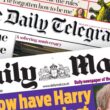UPDATED: 7 March : IPC Media – one of the world’s most famous magazine groups – is celebrating its 50th anniversary in 2013. Or rather, it isn’t. The London-based company may have decided there’s no reason to party. Business is tough, copy sales and advertising are sliding, and profits have fallen by more than two-thirds in 10 years. And now parent company Time Warner is floating the company off as part of Time Inc. It’s effectively up for sale.
The announcement came today after abortive negotiations to sell IPC (along with most of Time Inc’s 130 magazines including Time, Sports Illustrated and People, America’s most profitable magazine) to Meredith Corp, US publisher of Ladies Home Journal, Better Homes & Gardens, and Family Circle.
Those bumpy, unlikely, on-off talks helped Time Warner to soften up shareholders and staff for the divestment of its magazines. But the meetings with the small-town, risk-averse Meredith, also convinced executives of four things:
- Spinning the magazines into a separate, quoted company – at a time of buoyant stock markets – is likely (eventually) to give Time Warner the best ‘low-effort’ price for its unwanted magazine assets at a time of inexorable decline in profits – and without the risk of being left with a handful of titles (eg Time, Fortune and Sports Illustrated) as would have happened in any deal with Meredith.
- Actual maximisation of value from the sprawling magazines business across the US, Mexico and the UK will otherwise entail substantial reorganisation, including the break-up of IPC Media; and the parent company certainly does not have the stomach for that.
- The spin-off will lead to a substantial ‘re-rating’ of the core Time Warner business in much the same way as News Corp’s split of its publishing from the Fox TV and film operations. The cashed-up ‘new’ News Corp may itself even seek to buy Time Inc…
- Today’s announcement is unlikely to mark the ‘end game’ for the Time Inc business. Executives expect substantial divestments and even, ultimately, a merger with a non-publishing group which could (perhaps) harvest the digital potential of the company’s major magazine brands. Time Warner chiefs believe that possible suitors could include Amazon, Apple, Google/YouTube, Microsoft – and News Corp. They expect the competitive tussle to boost proceeds from the spin-off.

The promised appointment of a new Time Inc CEO may not even materialise, given the rumours now swirling around Time Inc., and which might pre-empt the flotation plans. But an eventual sale or break-up of IPC Media does look increasingly likely – whether or not Time Inc makes it back onto the stock market. The Meredith-Time talks are known to have been punctuated by whispers of how London profits could be increased by scaling back to its major earners and then investing in ecommerce partnerships to create new growth. So private equity buyers are getting ready.
Sale of IPC Media in a quick, cut-price deal – pending the flotation of Time Inc in the US – is also now considered a distinct possibility. It has been further encouraged by the price war sparked this week by the UK launch of TV Pick by Richard Desmond’s Express Newspapers in what is IPC’s most profitable sector. The buccaneering owner of Channel 5 and OK! may even want to tempt Time Warner with an opportunistic bid for IPC’s largest magazines.
Today’s developments cast a long shadow over a historic UK company which has dominated UK media for much of The Magazine Century. It was formed in 1963 by the merger of three competing companies – Odhams, Newnes, and Fleetway – which in 1968 added the Daily Mirror newspapers. Incredibly, it became almost a UK monopoly of magazines and popular newspapers. But the 1960s were the difficult-to-imagine times when the British government was encouraging mega-mergers in the belief that conglomerates were vital to international competitiveness. Thus, IPC became the publisher of more than 100 magazines, including the country’s four major women’s weeklies together selling some 8million copies, and publications across almost every sector. It also had business magazines, newspapers, books, children’s comics, and printing; and was part of a group with sprawling interests across the manufacturing of paper, paint and building materials.

The company’s early years were characterised by Brits as the “Swinging Sixties”. It was boom time also for IPC which, for 10 years, published the ultra-chic Nova among its raft of hot magazines for fashionable times. But then the serious competition began, fuelled by new full-colour printing presses, the growth in advertising revenue, in UK living standards – and IPC’s own exploding profits.
Competitive magazines started to come thick and fast, through the expansion of UK regional publisher EMAP, BBC launches of TV-linked magazines, the arrival of German publishers Gruner & Jahr and Bauer, and the expansion of US-owned Hearst and Conde Nast. It became easy to lampoon IPC as the “ministry of magazines” in a tower block – bigger, richer and maybe slower moving than its newer, smaller, more agile competitors. But it was IPC which gave British readers Loaded, Look, Now, Look & Learn, the imported Marie Claire and In Style, and the market’s steadiest presence Country Life.
IPC was milked for profits, first by the Reed Elsevier conglomerate and then by the Cinven private equity firm which bought the company in 1998 for £860m. Having flirted with the whizzy dotcom idea of merging IPC with a digital wunderkind (including Future Plc, for one), Cinven managed to sell the business for £1.15bn in 2001 to Time Warner, which had merged a year earlier with AOL. That was still being hailed as a perfect marriage of new-old media, with the full scale of the disastrous deal yet to be admitted. And the Time-IPC combination was also considered to be a pretty smart move – but not by everyone..
Time Inc had, for over 60 years, been a different kind of magazine publisher, of major weeklies like Time, Fortune, Sports Illustrated, Life, People, and Entertainment Weekly. It had become the largest magazine publisher in the US, flying high above the hyper-competitive and fragmenting markets for women’s and specialist magazines. Some good folks at Time Inc clearly did not quite see it that way. In 1995, they paid a then publishing record $498million for Alabama-based Southern Progress, which brought magazines like Southern Living, Coastal Living, and This Old House. That entry into the ‘new’ world of niche magazines led directly to the acquisition of IPC six years later – and, now, to the spin-off of the whole lot for a fractional price.

The original Time Inc stable of large national weeklies seemed to offer synergies with the parent company’s cable TV businesses, but special interest and women’s ‘service’ magazines in the US, Mexico and the UK was always a stretch. However, the man who promoted the IPC acquisition was Time Inc chairman Don Logan, who had himself joined the company along with Southern Progress. So he was all over a strategy to publish lots of magazines all over the world. And he made IPC’s executives feel right at home. Logan said: “This is the perfect acquisition for AOL Time Warner because it accomplishes key strategic goals for the company. With some of the best-known consumer publishing brands in Europe, IPC provides Time Inc with an important presence within the European consumer publishing sector. This acquisition also furthers AOL Time Warner’s goal of expanding our operations outside of the US.”
But the unbridled enthusiasm for magazines large and small – inevitably did not survive the quick succession of Time Warner chiefs then drafted in to unravel the AOL fiasco – described by current Time Warner chairman Jeff Bewkes as “the biggest mistake in corporate history”. Whether or not Bewkes thinks the magazine deals were also a major corporate mistake, nothing comes close to the AOL deal for the sheer destruction of shareholder dollars.
And anyway there was a glorious honeymoon for IPC. It was marked by a move into the Blue Fin landmark building on the south bank of Thames. Rising property values made that a financial coup – almost the high watermark of the company’s performance. But, soon after settling into their fine new offices, executives were hearing sell-off rumours, amid indications that Time Warner (by now, expensively shorn of AOL and the executives who bought it) would be ‘refocused’ around its TV, film and cable businesses.
Today, IPC Media is:
- 60 magazines read by almost two-thirds of all UK women and more than one-third of all men
- Web sites used by 25 million global users each month
- £300m turnover
But the numbers are not the real story. True, it continues to be a large, profitable magazine publisher with dominant shares in many of its best sectors, and some (but not nearly enough) promising digital operations. But total profits have almost halved in the

past four years, as the steam has gone from once high-growth sectors like celebrity weeklies, and men’s magazines. And IPC has the misfortune to be owned by a company now with no interest in magazine-centric media. Bewkes, who was responsible for building up Time Warner’s prize HBO cable business, has seemed motivated only to squash magazine investment and push for cost savings and price increases in a vain bid to slow declining profits – and hope for a buyer. The corporate web sites and their erratic explanation of which magazines are even published by Time Inc betray the lack of commitment. That was, of course, confirmed by the Time Warner talks with Meredith and, now, by the spin-off announcement.
It has been bad enough for the core Time Inc magazines, worse still for IPC Media across the Atlantic, left to put on a brave face and try to give the impression of equipping itself for the digital future when it has so clearly been denied the necessary funds to do so. Like so many traditional publishers, few of the IPC web sites touted as “digital properties” could actually ever become businesses in their own right. Most are ancillary to magazine brands and, therefore, face decline alongside the printed copies.
That is what successive would-be buyers have concluded. And last year’s IPC profits might have fallen to £30-35m – down from £37m in 2011 and £50m in 2010.
But look behind the headlines and you find that the UK group’s single most profitable magazine, the 1.2million-selling weekly What’s on TV, may effectively have accounted for almost 50% of the total profit. IPC has a market-leading 45% of the TV listings market which

– against all digital odds – continues to sell 4million weekly copies and is a rich seam of UK magazine profits, also for Bauer and Immediate (the former BBC Magazines).
Would-be bidders for IPC might be interested in further comparison with the highly-profitable London-based H.Bauer operation that pre-existed the German company’s £1bn UK acquisition of EMAP’s consumer magazines and radio stations. The 26-year-old, still largely-separate business, in an unfashionable corner of the city, publishes magazines including Bella (mid-age women’s weekly), Take a Break and That’s Life (real life and puzzles), and TV Choice (listings).
The 220 employees of that original H.Bauer UK business today generate some £25-30m of profit – almost the same as that made by the 1,800 people of the mighty IPC. The truth, of course, is that a small group of Bauer-like magazines at IPC would separately generate at least as much profit as the corresponding Bauer titles – because IPC’s clutch of like-for-like titles are collectively stronger. But, then, IPC Media is less than the sum of its parts: the case for a break-up that is not lost on Time Warner or any of the US corporates with which its executives have discussed the fate of their magazines.
So, sitting in her airy offices, IPC Media’s estimable CEO Sylvia Auton (who has spent 35 years managing almost every part of this vintage business) might be reflecting on the way that a break-up could yield rick pickings.
Apart from the Bauer-like weeklies, IPC has a joint venture for Marie Claire in the UK (probably generating profits of £400k), iconic titles like Country Life, NME, and Wallpaper, 50% of the steady and profitable home interest market, and 25% of fashion

and lifestyle magazines. The monthly Woman & Home is the only one of IPC’s top 10 titles to have increased its circulation since 2007; and subscribers account for almost half of its average 353,000 monthly sales, making it less vulnerable to newsstand cuts. Then there are potentially rich and dominant positions in boating magazines and in cycling. You can find significant pockets of magazine profit nearly everywhere – once freed of the overheads, constraints (and pension-deficit) of Time Warner’s unwanted subsidiary.
But, while it’s a good place to start analysing IPC, the future is not about maximising magazine profits. It’s about the changed dynamics of media and the factors that might inhibit or enable digital success, namely:
- Reduced advertising (let alone readership) revenues change the game for all those magazines (digital or hard copy) which depend for profitability on advertising. It may be different for digital-easy publications (like The Economist, The Week and Der Spiegel) whose reader revenues alone are sufficient to deliver profit, whatever the advertising. But most magazines will need to develop alternative revenues, presumably in ecommerce…
- Ecommerce dictates the need for new skills, resources, instincts and commercial relationships. Magazines have the brands and some content but they are only part of what is required to compete effectively with online retailers who can themselves readily buy in magazine-like skills (and are starting to do so).
- Magazine-centric teams will have to change substantially, to embrace new skills in technology and consumer insights, and video. The best ecommerce operations (whether by transformed publishers, digital newbies or traditional retailers) will be markedly less about content per se than about the functionality that provides a winning service for readers. The role of the Editor, for one, will not be quite as err supreme as in traditional magazine companies.
Magazine-centric businesses must increasingly move from producing products to creating services. That means a wholesale change in the business model and, perhaps, a recognition that many publishers might simply not be able to hack

ecommerce. That is becoming clear from the way that the digital natives (like Net a Porter and ASOS) are now acquiring traditional magazine skills; and it is just a matter of time before they move into online TV too. Even the strongest magazine brands may have trouble competing with online retailers coming down the media road from the other direction. (Repeat after me: Retail=Media, Media=Retail)
That is the coming-soon world for IPC Media and its next owners, would-be suitors and partners to contemplate. A time for urgent, radical change. The highly-efficient, scale-economy, centralised structure of IPC Media was fine when Time Warner first bowled in 12 years ago, but it won’t be OK when they bow out in the next few months.
But there can be some good news. A break-up could help progressive operators turn what are still some of the UK’s best magazine brands into formidable digital businesses. Just like 50 years ago, IPC is facing a dramatic future of ground-breaking change. The company that helped define the UK’s Magazine Century (alongside the PPA trade association that is celebrating its own centenary in 2013) could yet play a full-blooded role in this Digital Century. Happy Birthday.





I’ve dealt with the likes of alex russell and ian tournes in the past. With talent like that a company must be doing something right